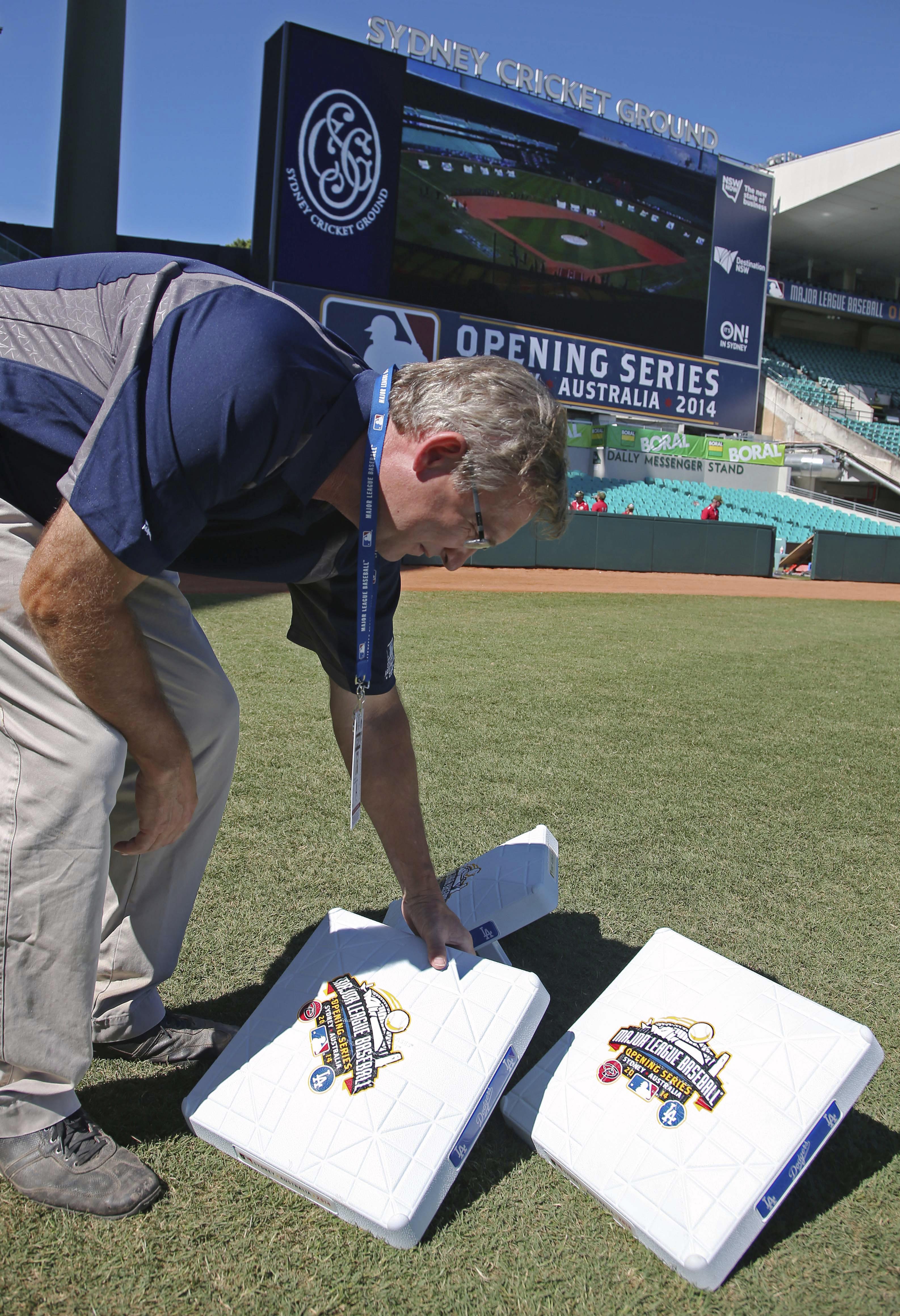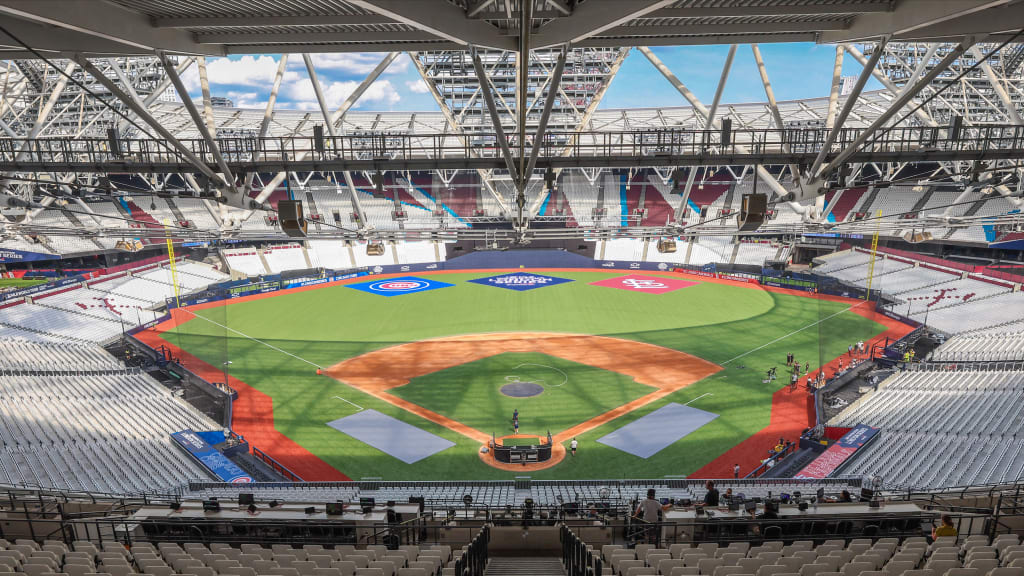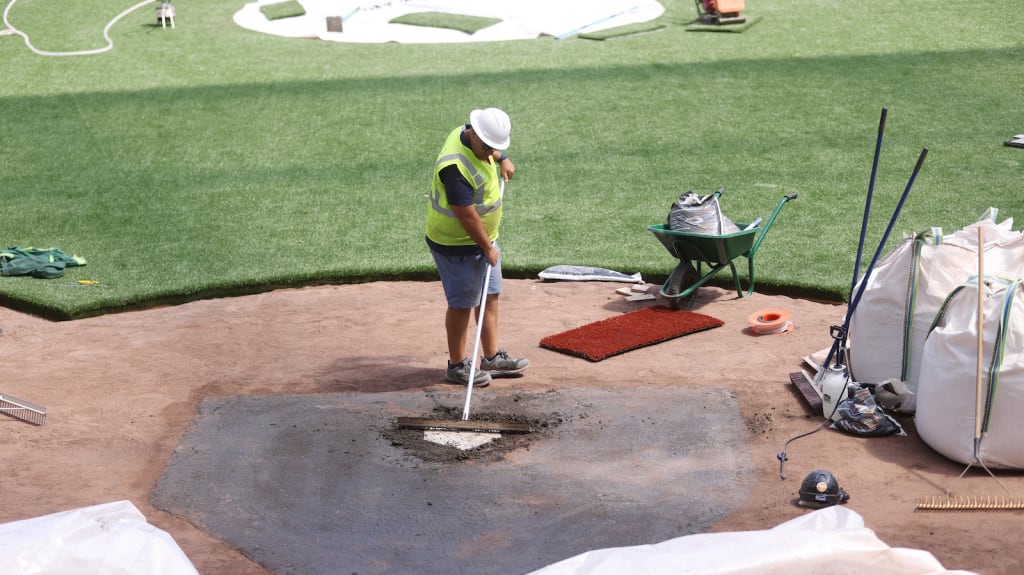Most Saturdays, London Stadium plays host to the English Premier League's West Ham United. The pitch is laid out in a rectangle, roughly 140 yards long and 100 yards wide.
On Saturday, though, it played host to the Cubs and Cardinals, whose playing requirements are a little different. To pull off the task of turning a pitch into a park, MLB turned to Murray Cook, its field consultant. Cook has built ballparks and fields all around the world, helping oversee projects as varied as the Dodgers' and D-backs' trip to Australia in 2014 to putting together a ballpark in a cornfield for the Field of Dreams game.
"The field is going to have regulation infield like you would see in any Major League ballpark," Cook told MLB.com during a walk-through before the London Series. "Full-size clay infield baselines, home plate, pitcher's mound -- bullpens are going in right and left field behind the right- and left-field corners."
Baseball had actually been looking at a way to play international games in soccer stadiums over a decade before the first London Series in 2019. But the process of converting a rectangular pitch into a playable field proved nearly impossible, necessitating a site like London Stadium, which also has room for track and field events.
"They just don't fit because you've got a right-field or a left-field fence that's 240 feet down the line," Cook said. "Doesn't work for baseball. Maybe exhibition, whatever, but not for a regular-season game. So we started looking at places where you've got a track and field venue, where now you've got the extra eight lanes plus the running lane and a shot lane. You've got this extra extended width that gives you another couple hundred feet. Even then, in '19, we were at 385 [feet] to center."

The 2019 Series was definitely tilted toward offense, with the Red Sox and Yankees combining to hit 10 home runs. This time around, Cook modified the shape of the field, finding extra footage wherever he could. Game 1 of the 2023 London Series saw the Cubs hit three homers -- two by Ian Happ -- while the Cardinals didn't leave the yard in Chicago's 9-1 win.
"This year we were able to do some things. The seats are changing here, so we're able to pick up another seven feet," Cook said. "We're 392 to center, we're 335 down the lines. We've narrowed the foul territory -- we've added some feet."
While Cook has figured out the best way to position a ballfield inside London Stadium, the hardest task is actually building the field. Once West Ham's season ended, the grass was stripped off so the stadium could host a concert series, leaving a flat plane of ArmorTec on the ground.
"It's like a big clean slate, or a palette for an artist to come and say, 'OK, what do we put now?'" Cook joked.
First, he had to sculpt the field. Though a ballfield may look flat, that's not exactly true.
"On a baseball field, the infield is relatively flat, [but it's also] slightly elevated. There's a little bit of a pitch on the infield dirt," Cook said. "And then it's flat in the outfield. A track-and-field venue and the flooring that goes on it has a pitch to it one way ... so we had to bring in aggregate to level everything."
The aggregate, made of small crushed stone, was four to five inches in some places, but up to eight inches on others to create the proper slope and layout of a big league park.

Next came the turf. Just as there are different varieties of grass -- Bermuda, Kentucky Bluegrass and Perennial Ryegrass to name a few -- there are varieties of turf as well. London Stadium will actually have a different surface used on the outfield grass as opposed to the warning track, so fielders will sense a shift under their feet just as they would on a natural grass field with a clay or dirt warning track.
The turf then has infill added to help mold the playing surface to behave the way you'd typically expect. The day we spoke, Cook showed off some small patches of turf they had experimented with, bouncing a baseball upon them to show the different effects each surface had on the ball. Though there's no clear standard for a baseball field the way an NFL or FIFA-approved pitch might, the London Stadium turf did go through a pretty rigorous inspection in nearby Leicester.
"We do a GMAX test, a Clegg hammer test, which demonstrates the hardness or softness of the field, which we did in '19," Cook said. "We also do a shoe test, where we actually put a shoe on the bottom of the device that torques it to determine how the spikes would fit into the turf. We do a water test to confirm it drains. We've gone through a lot of different components to see how it works."

While many think that artificial turf is easier to maintain than grass, thinking of it as a set-it-and-forget-it surface, Cook stresses that is simply not the case.
"There's a lot of work that goes into maintaining the edges where the clay is. The clay moves over in the grass, so you've got to sweep it back out of the grass," Cook said. "You've got a guy running on it, his shoes kick up the dirt when he's running. Well, guess what's happening to all that infill in the outfield when they're running around? It's kicking up, so you've got to come back out and groom after practices and workouts to make sure all that infill stays level."
And then of course there's another problem no one thinks about:
"Guys spitting sunflower seeds -- they just lay on top. They don't go anywhere," Cook laughed.
Now that the London Series is here and the field is set, Cook admits there is one thing he values over all else. It's not how perfectly the ball bounces or getting just the right slope of the infield in a place where midfielders usually run rampant.
"The number one goal for me is safety. I don't want anybody to get hurt," Cook said. "We want to make sure the field is safe. From the padding we put up, to the foul poles, to the lines [we draw up], we want those to be as as consistent as possible with a Major League ballpark."
